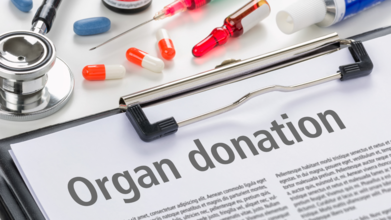- Health Conditions A-Z
- Health & Wellness
- Nutrition
- Fitness
- Health News
- Ayurveda
- Videos
- Medicine A-Z
- Parenting
- Web Stories
India Achieves Third Rank Globally With 18,900 Organ Transplants In 2024– What Happens If You Pledge To Donate Organs?

(Credit-Canva)
Organ donation is a selfless way to give back to one’s community and a great way to look out for those who are in grave need, even after your demise. This has been growing sentiment all over the world and India has come to show a massive rise in the organ donation sector. The Ministry of Health and Family Welfare announced the milestone achievement of India completing more than 18,900 organ transplants, the most ever in a single year. This is a big jump from fewer than 5,000 transplants in 2013.
Due to this effort, India is now third in the world for organ transplants, just behind the United States and China. Union Health Minister Shri Jagat Prakash Nadda spoke at the 15th Indian Organ Donation Day ceremony, he also noted that India is a world leader in hand transplants, showing the high skill of its surgeons.
The government is working hard to make organ donation easier for everyone. Since a new online pledge website was launched in 2023, over 3.30 lakh people have signed up to donate their organs. This shows that more and more citizens are willing to help.
To support this, the government is improving hospitals and training more staff to make sure organs can be moved quickly and safely. They also provide financial help of up to ₹15 lakh for poor patients needing a transplant and cover kidney transplants under the Ayushman Bharat PM-JAY health plan.
What To Expect When You Pledge To Donate Organs?
Organ donation can save lives, and there are two main ways to do it. According to All India Institute of Medical Science (AIIMS) you can choose to be a donor while you are alive, or your family can give their permission after you pass away. The Organ Retrieval Banking Organization (ORBO) helps coordinate this entire process. If you want to donate your organs after you die, you can pledge to be a donor now. Here’s how it works:
Fill out a form: You can get a free donor form from ORBO's website or by contacting them directly.
Get it signed: You need to fill out the form and have it signed by two witnesses, one of whom should be a close family member.
Send it in: Mail the completed form back to ORBO.
Receive your card: ORBO will send you a donor card with a registration number.
Tell your family: It’s important to keep your donor card with you and tell your family about your decision. This helps make sure your wishes are known.
Who Can Donate Organs?
The Kerala State Organ and Tissue Transplant Organization (K-SOTTO) explains that generally, anyone can donate organs or tissues, regardless of age. People with conditions like cancer or HIV are typically not able to donate, but even these rules can be flexible in certain situations. Before any organs are used, doctors will run tests to make sure they are healthy and won't pass on any diseases. The final decision on whether an organ is suitable for donation is made by doctors at the time of death.
Informing Your Family Is Important
K-SOTTO states that in India, the most important step for an organ donor is to talk with their family. Your donor card is not a legal document; it only shows your wish. By law, organ donation can only happen if your family gives written permission. That's why it's crucial to tell your family about your decision. Explain why it matters to you so they will be more likely to honor your wishes if the time comes.
Organ Donation After Death
AIIMS adds to the previous point and explains that even if a person did not register as an organ donor, their family can still choose to donate their organs after their death. The family simply needs to sign a consent form, and the organs are then quickly and respectfully removed within a few hours. The Organ Retrieval Banking Organization (ORBO) team manages this entire process, ensuring that the body is returned to the family in a dignified manner with no disfigurement. This allows funeral arrangements to proceed as normal.
Pledging your organs is simply the first step towards the donation process, having open conversations and necessary dialogues with your family, health care professionals will ensure the process happens smoothly.
Why Ignoring That Nausea Which 'Comes And Goes' Could Be Dangerous For Your Heart

Credits: Canva
Most of us brush off nausea. We blame something we ate, stress, skipping a meal, or even the weather. But what if your body is whispering something far more serious? If nausea keeps coming and going—especially if you're over 40 or dealing with other health issues—it could be more than just a stomach quirk. It might be your heart.
Sounds dramatic? It isn’t. In fact, experts warn that this seemingly minor symptom could be an early sign of heart trouble, particularly in women and older adults. And it often goes unnoticed—until it’s too late.
We tend to associate heart attacks with clutching chest pain and collapsing. That’s partly why subtle or unusual signs—like nausea—get ignored. But doctors are sounding the alarm that the body doesn’t always scream when the heart is in trouble. Sometimes, it nudges.
“One of the most overlooked warning signs of heart trouble, especially among Indian patients, is nausea or a vague, unsettled feeling in the chest that comes and goes,” says Dr Yusuf M M, Consultant Cardiac Surgeon at Apollo Hospital, Chennai. “Most people don’t link this to the heart. They assume it’s acidity, gas, or just fatigue.”
Unfortunately, that assumption can delay critical care. According to Dr Yusuf, many patients come in days or even weeks after first experiencing these “weird” sensations, only to learn they were actually early symptoms of a cardiac event. “Not all heart symptoms are dramatic,” he explains. “Chest pain might feel like tightness, dullness, or heaviness. Nausea, dizziness, or a cold sweat—especially if it’s unusual or recurring—should never be ignored.”
Why Is There A Gender Gap in Heart Symptoms?
Women are especially at risk of missing the signs. Studies show that women tend to have “atypical” symptoms during heart attacks—nausea, fatigue, back pain, and shortness of breath—rather than the textbook crushing chest pain seen in men.
Because these symptoms are vague, they’re often misattributed to hormonal fluctuations, gastrointestinal issues, or stress. This makes it even more important to look at the bigger picture.
Is the nausea happening alongside breathlessness, sweating, or unusual fatigue? Does it come on during physical exertion or after emotional stress? If yes, it’s time to stop dismissing and start investigating.
Why We Often Overlook Heart Signs?
In many parts of the world, including India and the US, over-the-counter remedies are often the first line of defense. A wave of nausea? Pop an antacid. Feeling uneasy? Try some ginger tea. While these may ease temporary discomfort, they can also mask serious issues.
“In India, where home remedies are common, we often miss the critical window for early intervention,” says Dr Yusuf. “That’s why even mild or odd symptoms deserve a closer look.”
But this pattern isn’t limited to one region. Across the globe, people routinely downplay symptoms out of fear, denial, or the simple belief that “it’s probably nothing.” In the case of heart issues, this mindset can be dangerous.
Who’s Most at Risk?
Dr Anbarasu Mohanraj, Clinical Lead & Senior Consultant, Cardiovascular & Thoracic Surgery at Kauvery Hospital, Chennai, outlines a key principle: when it comes to the heart, “the body usually whispers before it screams.”
According to him, lingering nausea, sudden dizziness, or vague chest discomfort shouldn’t be casually dismissed—especially if you fall into a higher-risk category. This includes people over 40, or anyone with high blood pressure, diabetes, a family history of heart disease, or a high-stress sedentary lifestyle.
“Prevention begins with paying attention,” Dr Anbarasu says. “If something feels off and you can’t explain it, get a quick ECG or cardiac enzyme test. These are simple, accessible, and can detect issues before they escalate.”
He also emphasizes that many heart conditions are manageable if detected early. What stands in the way? “Getting people to seek help before it’s too late. A little vigilance can save a life.”
When to Visit The Doctor?
Not every wave of nausea is a cause for panic. But patterns matter. Here’s what doctors suggest looking out for:
- Nausea that recurs without clear cause
- Accompanying symptoms like sweating, lightheadedness, breathlessness, or chest discomfort
- Nausea during physical activity or stressful situations
- Family history of heart disease or personal history of lifestyle risk factors
If you experience any of the above, don’t wait for it to get worse. Seek medical evaluation. An ECG, blood tests, or even a quick physical exam could make all the difference.
Your body is smarter than you think. It rarely throws out signals without reason. So, when nausea keeps showing up uninvited, listen to it. Don’t settle for assumptions or temporary relief.
Instead, ask the tough question- Could this be my heart trying to get my attention? As Dr Anbarasu puts it, “These minor signs could be your early warning. Don’t ignore your symptoms.”
In the end, it’s not about living in fear. It’s about paying attention—to the little things, the odd feelings, the symptoms that don’t quite make sense. Because sometimes, the difference between a scare and a crisis is simply getting checked in time.
If you’ve been brushing off recurring nausea, pause. Reflect, especially if you're over 40, living a high-stress life, or have known risk factors. The next time it happens, don’t reach for an antacid right away.
Just Looking At A Sick Person Can Trigger And Set Off Your Immune System

Credits: Canva
You've likely been through this when someone in the distance coughs or appears obviously sick, and you naturally change seats, look away, or quash a pang of unease. As it happens, that response isn't merely social learning or a wish not to catch something. It's your immune system going stealthily into high gear.
A recent study, published in Nature Neuroscience, finds that simply viewing indications of disease—even on a virtual individual—can prepare your brain and initiate immune responses, all without touching. Scientists employed virtual reality (VR) to examine how sensitive the human brain is to future health threats, and the findings are not only compelling—they're significant from a biological standpoint.
Researchers outfitted healthy adults with VR headsets that displayed avatars at different distances. Some avatars had feverish rashes or other visible signs of illness, while others looked neutral or simply fearful.
When participants viewed the "sick" avatars, their brains lit up in specific ways. Regions tied to threat detection, such as the hypothalamus, showed increased activity. And remarkably, these brain changes were accompanied by an uptick in immune activity—specifically, a rise in innate lymphoid cells (ILCs). These cells are typically mobilized when the body detects a pathogen physically. But in this case, there was no exposure—only the sight of illness.
ILCs are part of the body’s first line of defense. They're fast-acting, non-specific immune responders that kick in before antibodies have a chance to form. Think of them as your body’s internal first responders—and this study shows they might not even need a real fire to spring into action. A fire drill will do.
What Is The Immune System's Early Warning Radar?
Andrea Serino, one of the study’s senior authors, describes the body’s response as a kind of biological surveillance system. The brain spots a potential threat, and instead of waiting for direct contact, it nudges the immune system to be on standby. It's a bit like a security guard watching someone act suspiciously on a monitor—they may not be shoplifting yet, but help is already being called.
This system likely evolved to offer a head start against infections, which can spread rapidly. By giving the immune system even a few hours’ lead time, the brain buys the body precious time to gear up defenses. And it doesn't stop there. The study found that participants who viewed a virtual sick person reacted faster to physical stimuli (like a touch to the face) than when they viewed neutral or fearful avatars—evidence that the whole sensory system was more alert.
How Does Distance Makes the Body More Defensive?
One surprising twist: sick avatars that were shown further away triggered stronger brain and immune responses than those up close. That might seem counterintuitive, but researchers believe it speaks to the anticipatory nature of the brain. If a threat is far but approaching, the brain signals the body to prepare now. If the threat is already near, the body may consider it too late for prep—and instead focus on managing direct exposure.
Interestingly, some of the same brain areas activated in the study are also stimulated after a flu shot. That’s not a coincidence. Both experiences simulate exposure to a pathogen, whether real or perceived. Your brain doesn’t like to gamble when it comes to survival.
Is It The Body's Disgust or Defense?
Disgust plays a curious role here too. That natural recoil you feel when someone looks visibly unwell? It’s not just cultural. It’s also neurological.
The research broaches the concept that our feeling of disgust is perhaps an evolutionary behavioral immune system. That aversion aids us in keeping social distance away from potential carriers of infection. Researchers are still investigating how perceived infectiousness and disgust work together, but the research indicates this reaction is innately wired.
So, the next time you instinctively cringe when someone sneezes nearby or looks flushed and feverish—it’s not rudeness. It’s your body’s way of saying, “Heads up. Something’s not right.”
What this study powerfully underscores is that immunity isn’t just a physical reaction—it’s a neuro-immune conversation. Your brain doesn’t wait for pathogens to invade. It watches, it predicts, and it acts.
This has implications beyond the occasional cold season. It opens doors for understanding psychosomatic illness, autoimmune disorders, and even how chronic stress affects immunity. If simply perceiving a threat can trigger immune activity, what happens when people live in high-stress, high-alert states constantly?
It also highlights the sophistication of the human body. We’re not just passive recipients of disease. We’re vigilant systems designed to anticipate, respond, and sometimes even overreact to stay safe.
While the study provides strong evidence for visual illness triggering immune changes, it also raises important questions. For example:
Could this immune priming have downsides, such as contributing to chronic inflammation or anxiety?
Do people with autoimmune conditions react differently to perceived threats?
Can this mechanism be harnessed to boost immunity in vulnerable populations?
More research is needed to answer these questions, but what’s clear is that our immune system doesn’t start at our skin. It begins in the brain, the moment it sees something that doesn't look right.
You might not realize it, but your body is constantly scanning for danger—even from across the room. And in many cases, it reacts before you consciously know why. This study offers a compelling glimpse into just how interconnected the brain and immune system are.
Common Allergy Medications Risk Outweigh The Benefits, Why Experts Say It's Time To Rethink Its Use

Credits: Canva
Sneezing? Have a cold? Wheezing because of pollen? Take a cetirizine! This is what we do and have continued to do since so long, but, it may be now the time that we stop.
Diphenhydramine, a first-generation antihistamine approved in 1946, has long held a place in medicine cabinets worldwide. Commonly used to treat everything from seasonal allergies to bug bites, it also appears in nighttime cold medications and over-the-counter sleep aids. However, according to a recent review by allergy experts from Johns Hopkins University and the University of California, San Diego, it’s time to move on.
The study, published earlier this year, emphasized that while diphenhydramine does offer symptom relief, it comes with a host of potentially dangerous side effects, especially when safer, second-generation antihistamines like cetirizine, loratadine, and fexofenadine are readily available.
Dr. Anna Wolfson, an allergist at Massachusetts General Hospital, said she sees the medication misused in clinical settings far too often. “If someone has an allergic reaction to food, people will say, ‘Don’t worry, I have diphenhydramine in my purse,’ but really, epinephrine is the first-line treatment,” she noted. The sedative effect of the drug can actually mask worsening symptoms, putting patients in more danger. So if you thought sleeping it off helps, maybe not?
The Hidden Dangers: Sedation, Cognitive Impairment and Misuse
The review also highlighted how diphenhydramine interacts with the brain, often causing drowsiness, confusion, cognitive impairment, and even cardiac complications. These effects are more pronounced in older adults, where the drug’s effects can linger for up to 18 hours, leading to falls and disorientation.
In children, misuse has resulted in hospitalizations, paradoxical hyperactivity, and even fatalities, some tied to the viral and deadly “Benadryl Challenge” on TikTok.
The medication was also found to have no substantial clinical advantage over newer antihistamines in randomized trials. While it may reduce sneezing and itching, it offers minimal benefit for nasal congestion and often comes with more side effects.
Expert Insights on Tighter Oversight
Dr. Siri Kamath, a consultant in internal medicine at Gleneagles BGS Hospital in Bengaluru, agrees with the growing global consensus. “Diphenhydramine is an older antihistamine, and while it works, the safety cushion is thinner now, especially when anyone can buy it over the counter,” she said.
Dr. Kamath explains that while the drug can still be useful in emergencies, such as anaphylactic reactions when paired with epinephrine or in managing motion sickness and certain neurological conditions, its use in routine allergy management is unnecessary and potentially harmful.
She adds that regulatory bodies in India, such as the Central Drugs Standard Control Organization (CDSCO) and the Indian Pharmacopoeia Commission (IPC), monitor drug safety through real-world data. “When a drug begins doing more damage than healing, especially with safer choices available, it sparks a fresh look from regulators,” she notes.
Misuse Is a Key Part of the Problem
Diphenhydramine’s accessibility without prescription has made it susceptible to misuse. Dr. Kamath says it’s not just the drug’s inherent properties, but also the lack of awareness among the public and the way it’s marketed. “Clearer labels, more thoughtful dispensing by pharmacists, and public awareness can go a long way in preventing misuse,” she said. “We can’t overlook troubling trends online. This medicine does its job when used right, but without proper checks, its easy access can turn into a silent danger.”
This sentiment is echoed by American pharmacists and pediatricians who report that the medication is often misused in children for sleep and cold symptoms, despite its limited efficacy and serious risks. Saline drops, suctioning, or second-generation antihistamines like cetirizine are now preferred options for children above six months.
The Case for Moving Diphenhydramine Behind the Counter
Globally, experts are now calling for diphenhydramine to be either removed from the over-the-counter market or moved behind the counter to ensure pharmacist oversight.
In India, Dr. Kamath suggests tighter regulation rather than a blanket ban. “Instead of a full ban, we need better communication and tighter dispensing rules,” she said.
The Consumer Healthcare Products Association, which represents manufacturers like Benadryl's maker Kenvue, maintains that the medication is safe when used as directed and already includes clear warning labels. However, with over 1.5 million prescriptions still written annually in the U.S. alone, and countless untracked OTC purchases worldwide, some experts believe more than warning labels may be needed.
Balancing Familiarity with Evidence
For many patients and families, diphenhydramine is a go-to remedy that evokes familiarity and trust. But Dr. Kamath cautions against letting that history cloud present risks. “So many patients hold on to older medicines not out of defiance, but because they’ve leaned on them for years. But familiarity should never come at the cost of safety.”
© 2024 Bennett, Coleman & Company Limited

